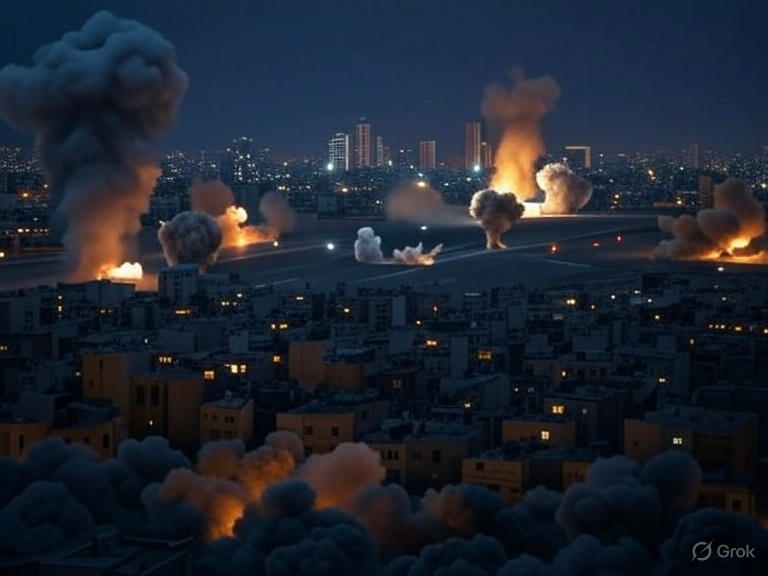Introduction
The Israel-Iran conflict, a long-standing geopolitical rivalry, has escalated dramatically in recent days, plunging the Middle East into a volatile new chapter. As of June 18, 2025, the two nations are engaged in a sixth day of direct military exchanges, with Israel launching airstrikes on Tehran and Iran retaliating with hypersonic missile attacks on Israeli cities like Jerusalem and Tel Aviv. This blog explores the latest developments, their implications, and the broader context of this intensifying crisis.

Recent Developments
The current wave of violence began on June 12, 2025, when Israel launched unprecedented strikes targeting Iran’s nuclear facilities, military bases, and infrastructure, including the Natanz uranium enrichment facility and Tehran’s oil depots. These attacks reportedly killed several high-ranking Iranian military officials and nuclear scientists, dealing a significant blow to Iran’s military and nuclear capabilities. In response, Iran fired over 370 missiles and hundreds of drones at Israel, with strikes hitting civilian areas and causing at least 24 deaths and over 500 injuries in Israel. In Iran, the toll has been heavier, with at least 224 people killed, including 70 women and children, and 1,277 injured.
On June 17, Israel intensified its campaign, striking Iran’s state-run television station during a live broadcast and targeting missile sites and air defense systems across western and central Iran. Iran’s Supreme Leader, Ayatollah Ali Khamenei, vowed retaliation, declaring that Israel “will be punished for its mistake” and that the “era of hit-and-run is over.” Iran’s latest salvo included Fattah-1 hypersonic missiles, escalating the technological stakes of the conflict.
International Reactions and U.S. Involvement
The conflict has drawn significant international attention. At the G7 summit in Canada, leaders reiterated their “commitment to peace and stability” in the Middle East but stopped short of calling for a ceasefire, while affirming Israel’s right to self-defense and labeling Iran as a “source of regional instability and terror.” U.S. President Donald Trump, who left the summit early to address the crisis, has taken a hardline stance, demanding Iran’s “unconditional surrender” and warning Tehran’s 10 million residents to evacuate. Trump has also suggested the U.S. might strike Iran’s nuclear facilities, a move that could risk a broader regional war.
Russia condemned Israel’s strikes on Iran’s nuclear sites as “illegal” and warned of a potential “nuclear catastrophe,” advocating for diplomatic solutions. German Chancellor Friedrich Merz indicated that destroying Iran’s nuclear program might require U.S. military assistance, as Israel lacks the capability to do so alone. Meanwhile, Iran’s Foreign Ministry warned that U.S. intervention would be a “recipe for all-out war in the region.”
The Broader Context
The Israel-Iran conflict is rooted in decades of ideological and strategic rivalry. Israel views Iran’s nuclear ambitions and support for proxy groups like Hezbollah as existential threats. Iran, meanwhile, perceives Israel’s regional dominance and U.S. backing as a challenge to its sovereignty. The current escalation was triggered by Iran’s non-compliance with the International Atomic Energy Agency’s non-proliferation commitments, prompting Israel’s preemptive strikes.
The human cost is mounting. In Tehran, civilians face panic and confusion, with long queues for fuel and blocked highways complicating evacuation efforts. In Israel, missile sirens and strikes have disrupted daily life, with commercial airspace closed, stranding thousands. The conflict’s ripple effects are felt across the region, with Iranian missiles visible over Lebanon and fears of disruptions to the Strait of Hormuz, a critical oil shipping lane.
Potential Outcomes
The trajectory of this conflict remains uncertain. Israel’s strikes have reportedly weakened Iran’s air defenses and missile capabilities, but Iran’s leadership remains defiant, with Khamenei warning of “irreparable damage” if the U.S. intervenes. Some analysts suggest Israel’s strategy is to degrade Iran’s nuclear program to prevent it from achieving a nuclear weapon, a goal supported by Trump’s rhetoric. However, the risk of a prolonged conflict or a wider regional war looms large, especially if foreign powers become directly involved.
Diplomatic efforts appear stalled. Iran has signaled openness to de-escalation in the past, but only under conditions of mutual restraint, which Israel has rejected. The G7’s call for peace has not translated into concrete action, and Trump’s dismissal of a ceasefire in favor of a “real end” suggests a preference for military pressure over negotiation.
Conclusion
The Israel-Iran conflict, now in its sixth day as of June 18, 2025, represents a dangerous escalation with far-reaching implications. The exchange of missile strikes, targeting of critical infrastructure, and inflammatory rhetoric from both sides risk plunging the Middle East into a broader war. While the G7 and other international actors advocate for stability, the lack of a clear path to de-escalation and the potential for U.S. involvement heighten global concerns. As civilians in both nations bear the brunt of the violence, the international community faces the urgent challenge of preventing a catastrophic escalation.
For ongoing updates, sources like Al Jazeera, CNN, and The New York Times are closely tracking the conflict. Stay informed, and let’s hope for a resolution that prioritizes peace and human lives.
